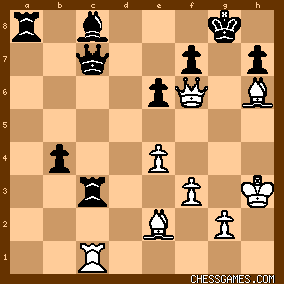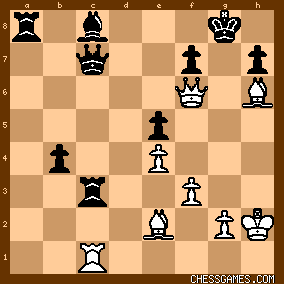|
< Earlier Kibitzing · PAGE 2 OF 2 ·
Later Kibitzing> |
| May-10-17 | | agb2002: White has a bishop for a rook.
Black threatens Ra2 and Ba6.
White can exploit the weak dark squares around the black king with 32.Qf6, threatening Bh6: A) 32... Ra2 33.Bh6 Rxe2+ 34.Kxe2
A.1) 34... Qg3 35.Qd8#.
A.2) 34... Ra2+ 35.Kf1 Ba6+ 36.Kg1 and mate soon. A.3) 34... Ba6+ 35.Kf2 and mate in two.
B) 32... Qh2 33.Bh6
B.1) 33... Qxh6 34.Qxh6 + - [Q vs r] (34... b3 35.Rh1, etc.). B.2) 33... Rxf3+ 34.Kxf3 Qh5+ 35.Kf2 Qg6 36.Qd8#. C) 32... Rxf3+ 33.Bxf3 Ra2+ 34.Kg1 and Black cannot protect simultaneously d8 and g7, as in B.2. |
|
| May-10-17 | | Once: It's a double GOOT. White gives black two free moves while he plays Qf6 and Bh6, but there is nothing black can do to prevent an eventual Qg7#. Grisly. |
|
| May-10-17 | | goodevans: <OhioChessFan: Hard to believe 10 years after this travesty, Black is WC.> Maybe the ignominy of this defeat caused him to change his name to try to avoid ever being connected with it again, but you've sussed him out. Well done! |
|
| May-10-17 | | whiteshark: I thought that <32... Rc3> was the best defense, missing that after <33.Bh6 Qxc5+ 34. Kg3 Qc7+ 35.Kh3 e5+> the simple retreat <36.Kh2> wins because black had closed the diagonal (b8-h2) with his last move [while in my reflection / mind it was still open]. pos. after 35.Kh3:

click for larger viewpos. after 36.Kh2:

click for larger view |
|
| May-10-17 | | morfishine: <32.Qf6> fixes Black's f-pawn in place; Now Black cannot prevent 33.Bh6 followed by mate; Its premature to move the White Bishop on move 32 since this allows 32...f5 and the Black Queen covers <g7> ***** |
|
| May-10-17 | | Walter Glattke: I found "a fish" for the bish: 32.-Qh2
33.Bh8 Kf8 34.Qd8# he only can prolong the mate, but not stop it with Qh2. |
|
| May-10-17 | | Walter Glattke: Ah, 33.Bh8 Qh6! yes, stops mate so far. |
|
| May-10-17 | | Walter Glattke: I'm too quick: 32.-Qh2 33.Bh8 Qh6
34.Qxh6 Kxh8 35.Qf8# is that right now!? |
|
| May-10-17 | | Iwer Sonsch: <32.Bh6 e5> (f6 Qxf6-g5-g7 mates) <33.Qxb4> with the intention of c6 looks like a major threat. Okay, the game line is stronger. |
|
| May-10-17 | | Iwer Sonsch: My lines don't work at all. After 32...f6 33.Qxf6 Ba6! 34.Qg5+, Black has 34...Kh8! and White only gets perpetual. 32...e5 is even stronger. |
|
| May-10-17 | | TransfiniteCardinal: Got it but since the key move QF6 is quiet I took a couple of minutes. |
|
| May-10-17 | | patzer2: Correction: All 22 other games in the OE reflect the computer choice and my preference 10... bxc3 = (+0.04 @ 28 depth, Stockfish 8) as in White's win in Carlsen vs R S Jones, 2007 or ... |
|
| May-10-17 | | Carlos0012358: 32....Ba6?? Really?? |
|
| May-10-17 | | Walter Glattke: Carlos, is all one move too late, stopping the mate with queen sac
32.-Qe7 is better. 33.Qxe7 Kxg7 seems to be the best answer. |
|
| May-10-17 | | Pasker: I don't think its a silly puzzle at all..Qf6 is somewhat a hard move to find. Most beginners like me will only be thinking about moving that bishop to the side somewhere and prepare a checkmate but that's never gonna work since f6 f7 followed by Bb7 white stopped the mate threat. But the quite Qf6 stop that pawn from moving and guaranties the check mate for you. A nice and quite forcing move. |
|
| May-10-17 | | saturn2: I saw that after 32 Qf6 black is lost. Counterplay by Ra2 and Ba6 comes to late.
32 Qf6 also prevents blacks Qd8 or Qe7. |
|
| May-10-17 | | Walter Glattke: 32.-Qh2 33.Bh8 Qh4+ 34.Qxh4 Kxh8 wins over Pc5: 35.Qh6 Bb7 36.Rh1 Kg8 37.Rh3 f5 38.Qxh7+ Kf8 40.Qh8+ Ke7 41.Rh7# |
|
| May-10-17 | | beenthere240: It's not a combination, but an instructive maneuver that blocks Black's only freeing move. |
|
| May-10-17 | | gars: <beenthere240> is one hundred percent right. |
|
| May-10-17 | | Walter Glattke: 32.-Rc3 33.Rd1 Qxc5+ 34.Kf1 Bb7 35.Bh6,
another way for whiteshark idea. |
|
| May-10-17 | | Strelets: One of those times where move order is everything. White has already sacrificed the exchange and Black has a dangerous looking passed b-pawn; in other words, any mistake would be fatal. Black's chief defensive resource against an attack on his weakened dark squares lies in moving the f-pawn so that his queen can defend the seventh rank. White avoids this by slipping 32.Qf6 in first. Suddenly, Carlsson has no defense and can only avoid being checkmated at the cost of his queen. |
|
| May-10-17 | | malt: 32.Qf6 nails down the f-pawn |
|
| May-10-17 | | swclark25: I appreciate <Pasker's> comment. I wanted to move the Bishop then bring in Queen, but Black f6 would have thwarted. |
|
| May-10-17 | | morfishine: <Pasker> & <swclark25> Yes, in OTB analysis, many times we don't see the best line first. So we need to move quickly between lines (eliminating faulty trails) when deciding on a starting move, to at least find a good move Around here, frequently you will find multiple alternative moves that also win, thats perfectly acceptable too Here today, I looked first at stuff like <32.Bh8> or <32.Bh6> but I soon saw these moves let Black move the f-pawn; So that led me to <32.Qf6> Process of elimination in a way, done quickly
***** |
|
| May-11-17 | | Carlos0012358: <Walter Glattke>: Carlos, is all one move too late, stopping the mate with queen sac 32.-Qe7 is better. 33.Qxe7 Kxg7 seems to be the best answer. The best answer is a queen sacrifice (32....Qf4, 33.Qxf4 Kxg7) so as to remove the bishop/queen mate threat. The position is lost anyhow. |
|
 |
|
< Earlier Kibitzing · PAGE 2 OF 2 ·
Later Kibitzing> |





